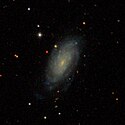NGC 3225
| Galaxie NGC 3225 | |
|---|---|
 | |
| SDSS-Aufnahme | |
| AladinLite | |
| Sternbild | Großer Bär |
| Position Äquinoktium: J2000.0, Epoche: J2000.0 | |
| Rektaszension | 10h 25m 09,9s[1] |
| Deklination | +58° 09′ 00″ [1] |
| Erscheinungsbild | |
| Morphologischer Typ | Scd: [1] |
| Helligkeit (visuell) | 12,6 mag [2] |
| Helligkeit (B-Band) | 13,3 mag [2] |
| Winkelausdehnung | 2′ × 1′ [2] |
| Positionswinkel | 155° [2] |
| Flächenhelligkeit | 13,2 mag/arcmin² [2] |
| Physikalische Daten | |
| Rotverschiebung | 0,007118 ± 0.000023 [1] |
| Radialgeschwindigkeit | 2134 ± 7 km/s [1] |
| Hubbledistanz vrad / H0 | (99 ± 7) · 106 Lj (30,2 ± 2,1) Mpc [1] |
| Durchmesser | 55.000 Lj |
| Geschichte | |
| Entdeckung | Wilhelm Herschel |
| Entdeckungsdatum | 8. April 1793 |
| Katalogbezeichnungen | |
| NGC 3225 • UGC 5631 • PGC 30569 • CGCG 290-037 • MCG +10-15-077 • IRAS 10218+5824 • 2MASX J10250992+5809000 • GC 2087 • H II 882 • h 703 • NVSS J102509+580858 | |
NGC 3225 ist eine Spiralgalaxie vom Hubble-Typ Sc[2] im Sternbild Großer Bär am Nordsternhimmel. Sie ist schätzungsweise 99 Millionen Lichtjahre von der Milchstraße entfernt und hat einen Durchmesser von etwa 55.000 Lj.
Das Objekt wurde am 8. April 1793 von Wilhelm Herschel entdeckt.[3]
Weblinks
Einzelnachweise
Auf dieser Seite verwendete Medien
Autor/Urheber: Sloan Digital Sky Survey, Lizenz: CC BY 4.0
The sky image is obtained by Sloan Digital Sky Survey, DR14 with SciServer.
Angle of view: 4' × 4' (0.3" per pixel), north is up.
Details on the image processing pipeline: https://www.sdss.org/dr14/imaging/jpg-images-on-skyserver/



